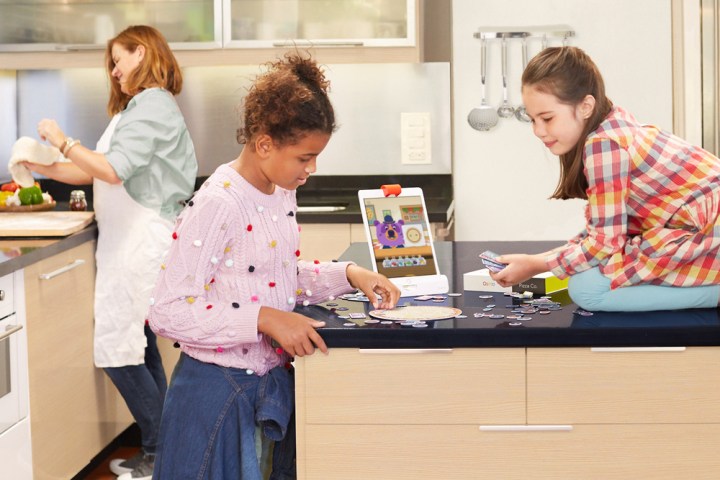
Osmo’s Pizza Co. takes the form of a boxed kit with two plastic trays of game pieces: one with cardboard cutouts of ingredients you are likely to find on an Italian pie and the other currency in the form of rectangular cardboard bills and coins of various denominations. The companion app is the other puzzle, and together, they form the foundation of the game’s premise: you are the proprietor — and sole employee — of a new pizza shop. You have a hankering for expansion, but progression is only possible if you perform your tasks efficiently.

That is where the fun begins. Once you place the cardboard pizza in front of the iPad’s camera and the accompanying trays within reach and select a difficulty level, you are officially open for business. Customers in the form of cute anthropomorphized animals come pouring through the animated doors with orders that run the gamut. Some prefer pepperoni over olives, or peppers with with a sprinkling of mushrooms — preferences they will make exceedingly clear with adorable murmurs of alternating approval and disapproval.
The next step is baking the pizza. Once every ingredient has been placed just so, a nudge of the physical pie to the right of the iPad triggers the corresponding onscreen pizza to move into an animated conveyor oven. As it is cooking, a right-hand icon indicates its level of readiness. After it is finished and plated, though, the real challenge begins: calculating correct change. Flip the cardboard pizza over and it becomes a countertop on which you place bills and coins; as you suss out what the waiting customer is owed, an onscreen total changes color to indicate when you are approaching the correct bill.

The intricate Pizza Co. is a bit of a departure from Osmo’s previous titles. The startup’s previous kits, like Coding and Masterpiece, sought to educate about specific subjects or encourage creative expression. Pizza Co.‘s endgame is a bit more nebulous, but Sharma said that is by design. “Kids experience what it’s like to run a business,” he told Digital Trends. “They have to think about it holistically, starting from the ground up.”
The goal from the beginning, Sharma said, was imbuing children with a level of responsibility. Elements of the pizza parlor can be upgraded, for instance, but at cost: if you want a more efficient oven or abstract art installation, it will take at least a shift or two to earn the required dough. “We want children to start with a small shop and expand to build an empire,” Sharm said. “We want kids to learn how to optimize how much to spend and increase satisfaction among customers.”

Perhaps the most transparently educational component under that big-picture umbrella is the mathematical component, which in Pizza Co. takes the form of money management. The app strikes a careful difficulty balance: while tabulating customers’ exact change becomes increasingly challenging as the difficulty ramps up, the answers always reveal themselves after a time. The intent is not to frustrate kids with challenging problems, Sharma said, but to motivate their progress.
He believes the tangibility of Pizza Co.‘s plays a vital role. “You’re given a [palpable] element that you can experiment with quickly,” Sharma said, referring to the game’s cardboard currency. “You’re forced to think about the pieces. You’re building blocks and putting things together in physical space.” And he contends that furthermore, those blocks enable social interactions that aren’t possible with with strictly digital apps. “You can play a game together with family or friends,” Sharma said.

But augmented reality is not without its own advantages. “Without the iPad, it’s not as rich as an experience,” he said. “Adding fantasy is the role of augmented reality, and we’re all about taking things that are classic and trying to add a new dimension,” Sharma said. “We’re trying to make things more exciting, more magical, and more approachable.”
Osmo’s Pizza Co. launches in Best Buy, Target, and Apple stores on November 1 in two models: the base kit, which starts at $40, and the Commerce Kit, which includes the Osmo game system base and mirror and two previous apps, the Newton and Mirror, for $60. It is compatible with the iPad 2, iPad (3rd and 4th Generation), iPad Mini, iPad Mini 2, iPad Mini 3, iPad Mini 4, iPad Air 2, and the iPad Pro.


